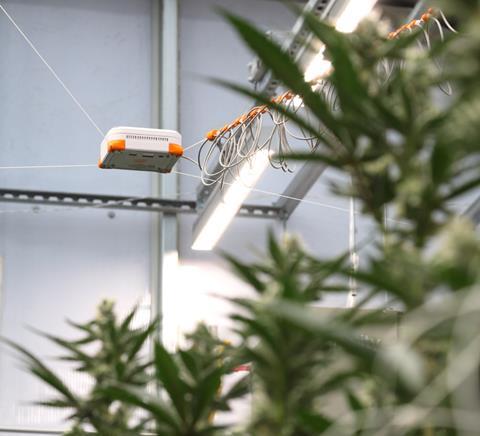The Neatleaf Spyder aims to offer a comprehensive understanding of the cultivation environment in the greenhouse, collecting data across the canopy and directing the grower’s attention to where it is most needed
Sounding somewhere between a forgotten comic book hero and a newly discovered species, the Neatleaf Spyder from Neatleaf promises to “keep an eye on every plant; all day, every day”. With offices in San Francisco and Munich, the company’s efforts initially centred on optimising cannabis production, but, as CEO Elmar Mair points out, “the technology’s agnostic” and highly suitable for use on all greenhouse crops.

The Neatleaf Spyder enables a grower to remotely monitor and optimise their growing environment for each individual plant, according to the company. “Know your environment conditions in every corner and rely on automatically collected plant health and growth metrics to guide your decision making,” promises the company’s website.
“In most other industries, the one thing you do when you want to optimise a production line is you capture data,” says Mair, “so you have sensors to help you understand what’s going on. In cultivation, however, we still heavily rely on humans to assess what’s happening in that space.”
The Spyder contains multiple sensors to gather a comprehensive understanding of the cultivation environment, collecting data across the canopy, ensuring consistency and interpretability, according to Neatleaf.
“Early on, we challenged ourselves to come up with a system that allowed us to capture all this information, which growers need to assess a crop and understand what’s going on, in a way that enables adoption,” says Mair. “That means low cost, easy to install, fully autonomous and out of the way of the operation.
“So we came up with the Neatleaf Spyder, which is basically a cable-based robot, like a football stadium camera, which is incredibly easy to install in a couple of hours, and then it zips around and captures all the data. It’s like a scouting robot that does way more than scouting.”
The dashboard gives the grower the zone status at a glance, summarising the conditions, as well as the trends, and directing their attention to where it is needed most.
“By automatically identifying plant stress multiple times a day across your complete canopy you will get a very strong signal for overall plant health and trends,” the company says. “Hot spots and systematic issues will become immediately apparent and allow you to respond quickly.”

“At the same time you have AI picking up on plant stress by analysing yellowing and pests,” explains Mair. “It gives you a heat map across the canopy to show how things have changed across the growth cycle. And you also get numbers, like 10 per cent less yellowing than the previous day. This changes the whole conversation, as it’s not subjective anymore, you can actually talk numbers.”
He says that the same is true with yield. “We measure flowers, count flowers, we can forecast yield, we can understand the growth rate, understand how your growth rate is impacted by your SOPs, understand how uniform the light is at different growth stages,” he adds. “And we measure leaf temperature, which is incredibly valuable.”
One big advantage of the Neatleaf Spyder, according to Mair, is that it allows growers to see microclimates. “When you notice an issue with the canopy, like smaller plants or lower yield, it is already too late,” he says. “But now we can go back in time and correlate those things and assess what was the indication. We can look at each individual plant and all the different data points. The most important thing is understanding stress. Transpiration is the first sign, and if you measure the leaf temperature you can understand that and measure it.”



